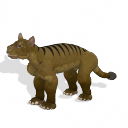ShopDreamUp AI ArtDreamUp
Deviation Actions
Suggested Deviants
Suggested Collections
You Might Like…
Featured in Groups
Description
Commonly known as the marsupial lion, Thylacoleo carnifex was a large, predatory marsupial mammal that lived in Australia during the Late Pleistocene (around 1,6 million - 46 thousand years ago). It stood around 70 cm tall and 1,5 metres in length, and weighed an estimated 100 - 130 kg, meaning it was about the size of a lioness or a tigress, or perhaps a large leopard or jaguar. It in the largest known indigenous carnivorous mammal in Australia, and one of the largest known carnivorous marsupials ever.
The first digits on the forelimbs bore enlarged claws that may have been used to grapple and cling to large prey, in a case of convergent evolution with the much earlier dromaeosaurid dinosaurs. Its claws were also retractable, like those of a cat.
Typical prey would've included other large marsupials such as the short-faced kangaroo Procoptodon, and the enormous Diprotodon.
Thylacoleo and other similar predators were descended from herbivores, so their teeth were very unlike those of more typical mammalian predators. Their canine teeth were small and stubby, but their incisors and carnassial premolars were large and blade-like. The carnassial teeth worked like scissors or shears, and were well suited for cutting. The carnassials were mainly used for severing the spinal chord and major arteries of prey. Aided by heavy and powerful jaws, the bite of this animal must have been something to be feared.
Thylacoleo was probably not a fast runner. Instead, it probably relied more on ambush tactics, and as it was well suited for climbing, it may very well have dropped down from large trees onto its prey. Scans of its brain cavity indicate that it had a good sense of hearing, smell and sight. It was also able to detect pheromones like the modern Tasmanian devil.
As the Australian megafauna began to die off and human settlers burned large areas of forest to make way for grasslands, Thylacoleo was unable to sustain itself on small, fast-moving prey, and starved into extinction.
Animals resembling Thylacoleo sometimes appear in Aborigine rock art. Many of them depict it as having multiple stripes running down its back, not unlike the thylacine. But unlike the thylacine, its ears appear to have been pointed rather than rounded, the stripes run all the way down its back instead of just in the hip region, and some drawings depict what looks like a tuft of hair on the end of its tail.
Feel free to download any of my Spore PNGs!
The first digits on the forelimbs bore enlarged claws that may have been used to grapple and cling to large prey, in a case of convergent evolution with the much earlier dromaeosaurid dinosaurs. Its claws were also retractable, like those of a cat.
Typical prey would've included other large marsupials such as the short-faced kangaroo Procoptodon, and the enormous Diprotodon.
Thylacoleo and other similar predators were descended from herbivores, so their teeth were very unlike those of more typical mammalian predators. Their canine teeth were small and stubby, but their incisors and carnassial premolars were large and blade-like. The carnassial teeth worked like scissors or shears, and were well suited for cutting. The carnassials were mainly used for severing the spinal chord and major arteries of prey. Aided by heavy and powerful jaws, the bite of this animal must have been something to be feared.
Thylacoleo was probably not a fast runner. Instead, it probably relied more on ambush tactics, and as it was well suited for climbing, it may very well have dropped down from large trees onto its prey. Scans of its brain cavity indicate that it had a good sense of hearing, smell and sight. It was also able to detect pheromones like the modern Tasmanian devil.
As the Australian megafauna began to die off and human settlers burned large areas of forest to make way for grasslands, Thylacoleo was unable to sustain itself on small, fast-moving prey, and starved into extinction.
Animals resembling Thylacoleo sometimes appear in Aborigine rock art. Many of them depict it as having multiple stripes running down its back, not unlike the thylacine. But unlike the thylacine, its ears appear to have been pointed rather than rounded, the stripes run all the way down its back instead of just in the hip region, and some drawings depict what looks like a tuft of hair on the end of its tail.
Feel free to download any of my Spore PNGs!
Image size
128x128px 23.99 KB
© 2014 - 2024 Tote-Meistarinn
Comments0
Join the community to add your comment. Already a deviant? Log In




































